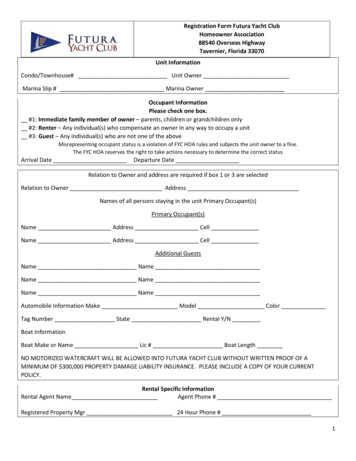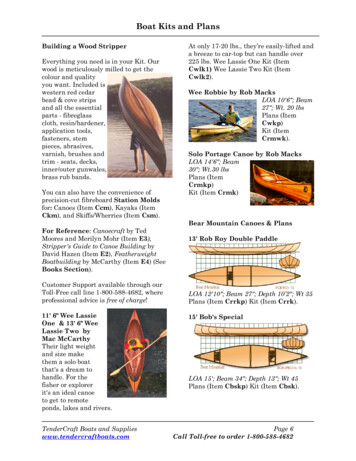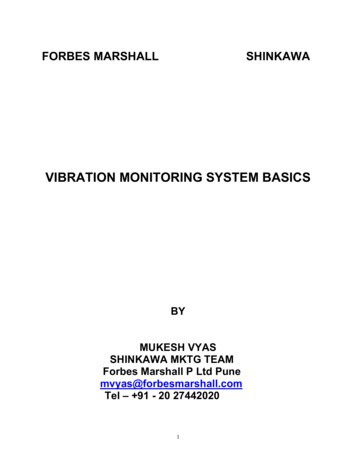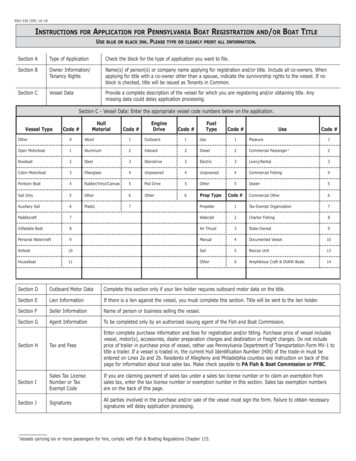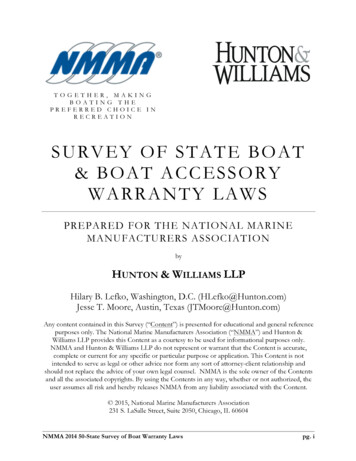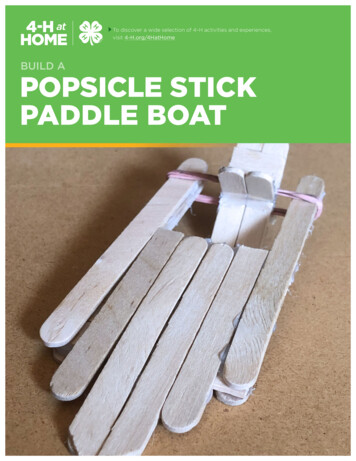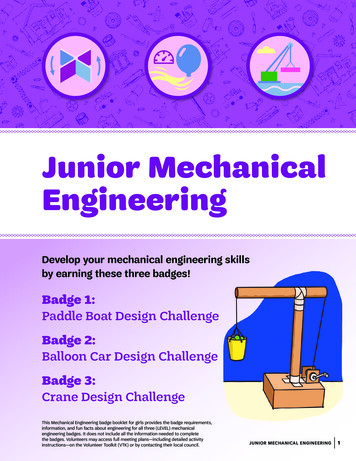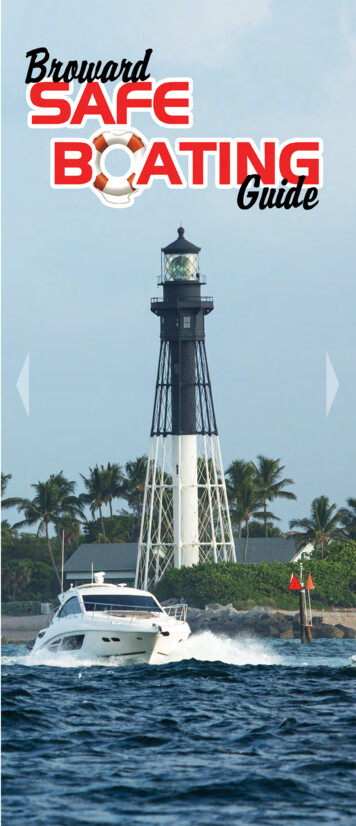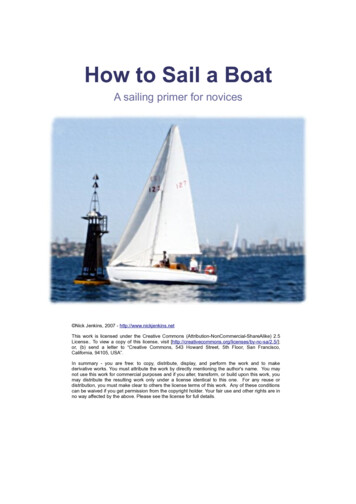
Transcription
How to Sail a BoatA sailing primer for novices Nick Jenkins, 2007 - http://www.nickjenkins.netThis work is licensed under the Creative Commons (Attribution-NonCommercial-ShareAlike) 2.5License. To view a copy of this license, visit ];or, (b) send a letter to “Creative Commons, 543 Howard Street, 5th Floor, San Francisco,California, 94105, USA”.In summary - you are free: to copy, distribute, display, and perform the work and to makederivative works. You must attribute the work by directly mentioning the author's name. You maynot use this work for commercial purposes and if you alter, transform, or build upon this work, youmay distribute the resulting work only under a license identical to this one. For any reuse ordistribution, you must make clear to others the license terms of this work. Any of these conditionscan be waived if you get permission from the copyright holder. Your fair use and other rights are inno way affected by the above. Please see the license for full details.
Table of ContentsHow to Sail a Boat.1Introduction.3Chartering.3Parts of the Boat.4Sails and Rigging.5Parts of sails.5Rigging.5Sail terminology.5The two types of sails.5Winches.6Loading a winch.6Cranking a winch.6Easing a winch.6Jammers, Cleats and Stuff.6Sailing Basics.7Points of sail.7Sailing into the Wind.8Tack, Tack, Tacking!.8Adjusting sail.8Tacking and Gybing.9Tacking.9Gybing.9What can I do?.10Miscellaneous Stuff.11Putting sails up and taking them down.11Anchoring.12Rules of the Road.13Safety.13The 7 F’s of Safety.13Emergencies and responses.14Man overboard.14Distress signals.14Radio.15Glossary.16
IntroductionSailing is fun. But – a lot of people are put off sailing by the complexity and strange terms.What exactly is a cunningham and how do you make it fast?Most people who get on a boat for the first time are baffled by the terminology and the obscure, arcanelanguage. Yet, there is a point to this language. Sailing has evolved over hundreds of years and, deep withinthe heart and mind of the universe, there is a reason for all this ‘stuff’.Quotes from “Overheard Sailing” (http://www.overheardsailing.com) :Dock person : Ok, Take this line and secure it to your aft cleat.Dock person : No! At the STERN of the boat!Dock person : NO! NO! That CLEAT there. There, on the back of the boat!Dock person : THE F--KING SILVER THING!!!-andCrew: It’s all very well, but you’re not making any friends here. I mean, thelanguage alone is alienating. What the hell is a halyard? You yell at me to pullit, you yell at me to let some sheets go. I’m not impressed. Teaching should becomplemented with sign language - pointing, for example. Call it ‘thingy’, call it‘that’. Complement it with direct action requests, i.e. ‘pull’ and ‘let go’. Then,people will reach out for you.Skipper: sigh Pull that, will you?Yes, it’s true – there’s a lot of bollocks that goes around sailing. If you listen to two ‘salties’ talking aboutsailing you might conclude that they are talking in another language or, at the very least, in another time.I wrote this guide because I like sailing and I meet a lot of people who want to try sailing. The problem is theydon’t know much about it and are daunted by the prospect of setting foot on a boat. Even if they manage geton a boat often they are so confused by the whole thing that they never come back.Hopefully this guide will let you understand the basics of sailing, let you talk about sailing without feeling likean idiot and, most importantly, make you useful on a sailing boat.CharteringI also wrote this guide because I often go cruising with friends who have never sailed before.If they’ve never stepped on a boat before, they feel as useful as a one-legged man at an arse kickingcontest. So, before we go, I distribute this guide so they understand what’s happening and, more importantly,can do some of the work.Skippers should feel free to use this guide with new crew, on the proviso that : its source is acknowledged(i.e. me); it is not used for commercial purposes; if you take and part of it to modify you must distribute itunder a similar agreement.
Parts of the BoatForeStarboardPortAftParts of the HullSheets and HalyardsBow – pointy bit at the front the boatStern – blunt bit at the backCabin – lump in the middle you sleep inKeel – big heavy fin-thing on the bottom of the boatthat keeps it from flipping overRudder – a movable fin at the back that steers theboat, connected to a wheel or tiller for steeringMain sheet – rope for controlling the mainsailJib sheets – ropes for controlling the jib, usually oneon either side of the mastHalyard – a rope for raising or lowering a sailSails, Stays and SparsMast – tall vertical stick the sails hang offBoom – horizontal stick hanging off the mastForestay – front wire keeping the mast upBackstay – back wire keeping the mast upSidestay – work it out genius.Mainsail or Main – the big sail behind the mastForesail or Jib – the ‘little’ sail in front of the mast(sometimes known as a genoa, ‘jennie’ etc)OtherTiller – a stick for steering, more fancy than a wheelDirectionsFore – towards the bowAft – towards the sternPort – to the left as you face the bowStarboard – to the right as you face the bow(NB: this is important, it might sound silly but consider this – thereis only ONE port on a boat, but there could be lots of lefts depending on which way everyone is facing)
Sails and RiggingParts of sailsThis diagram shows the parts of a sail on a typical sail (this is the mainsail).The top corner is called the head, the bottom corners are the clew and the tack. Onthis sail, the tack is close to the mast and the clew is at the end of the boom.The sides are called the foot at the bottom, the luff at the front near the mast andthe diagonal leech at the back.RiggingRigging is the ropes and wires on a boat involved with sails.Every ‘rope’ is named for its function and/or location. This is so whenthe skipper says “dump the mainsheet and take in the jib!” everyoneknows which rope to let go and which one to pull.A topping lift is used to raise or lower a spar, like the boom.A halyard raises or lowers a sail and would thus be attached tothe head of the sail.A sheet is a rope that controls the angle of the sail to thewind. It is usually attached to the clew.Sail terminology Take in / sheet in – to tighten or pull on a ropeHard on – as tight as a sheet or sail will go (e.g. “bring the jib hard on”)Let go / ease - to loosen or let out a rope (e.g. “ease the jib sheet”)Dump – to let go all at once, to ease as far as it will goLuffing – when a sail flaps at the front edge (i.e. the luff)Working sheet – a sheet that is tight, because it is holding a sail against the force of the windLazy sheet – a sheet that is loose, because it is doing nothing (no force)The two types of sailsBy and large you’ll only have to deal with two kinds of sails : the main and the jib. As you progress you mightdeal with other kinds of sails including different kinds of jibs and speciality sails like storm sails or spinnakers.For now we’ll concentrate on the main and the jib.The mainsail is the big sail behind the mast and is obviously very important to how the boat works. Themainsail is controlled by a single mainsheet that usually runs to a series of pulleys in the middle of thecockpit. The pulleys supply the extra force need to move the big mainsail when it is full of wind.The jib (in front of the mast) is equally important to how a boat sails, especially when it sails into the wind.The jib is controlled by two sheets which run down each side of the boat. When the boat is sailing one ofthese, the working sheet, will be under load as it holds the force of the wind in the sail. The other, the lazysheet, will be lying slack – essentially doing nothing. When the boat changes direction the lazy sheet and theworking sheet will swap sides. The lazy sheet will hold the sail against the force of the wind and become theworking sheet and the working sheet will go slack and become the lazy sheet.We’ll look at this in more detail later.
WinchesThe forces involved in sailing are sometimes morethan a single human can handle.To help we use winches.A winch is a mechanical device which multiplies theforce you can put on a rope. Because of the forcesinvolved, winches can be dangerous.You should keep your fingers clear of ropes onwinches if you don’t want to lose them!Loading a winchWinches usually work in one direction only.Generally it is clockwise, but not always. The easiest way to check is to put one hand on the winch beforeyou put the rope on and turn it with your hand. The rope must go on in the same direction as it turns.To ‘load’ a winch - wind the rope around the winch in the direction it turns, starting from the bottom andmoving up. Each turn must be flat against the surface of the winch and must not ‘ride over’ another turn.The more ‘turns’ or rope around a winch, the more friction and the more holding power there is. You shoulduse a minimum of three or maybe four turns (experienced sailors might use less). The winch pictured here is‘self-tailing’. It has a set of ‘jaws’ at the top into which the rope may be thrust to secure it. If a winch is notself-tailing the loose end of the rope must be either held or or secured to a cleat.Cranking a winchTo supply extra force, you can put a handle on the winch. The handle goes in the top of the winch and it canthen be cranked. Generally you can crank the handle in both directions. The body of the winch will still turnone way, but the two directions of the handle will supply different speeds and different forces. If you can’tcrank a handle one way, try cranking it the other.Never leave a handle in a winch! They can be knocked overboard and they are expensive. Always takethem out and put them away so you can find them next time. Usually there is a lever on top of the winchwhich you must move or depress to take the handle out of the winch.Easing a winchTo ease a rope on a winch it is not necessary to take it off the winch. The rope can be eased simply by takingthe loose end of the rope and feeding it into the winch. As the coils of rope become slack, the tension on theother side of the winch will pull the coils slowly out, allowing you to ease the rope under control.Jammers, Cleats and StuffRopes tend to flop around unless they are secured or made fast.A jammer is a mechanical device that secures a rope by clamping it betweentwo jaws. The jaws are activated by a lever on top of the jammer. To open ajammer, lift the lever and push it completely forward until it is parallel withthe rope. Halfway is not good enough! To close it, pull it back and down untilparallel with the rope.If the jammer won’t open normally this means the rope is under tension. Youneed to take the tension up on a winch before the jammer will open.Trying to open it under tension could be dangerous.A cleat is a metal hook around which a rope is wrapped to secure it.There is a particular figure eight method that is used on cleats which isdifficult to show here. Ask someone who knows how to use a cleat toshow you. Note that ropes are not tied to a cleat with a knot, they aresimply wrapped around them so they can be unwrapped when needed.
Sailing BasicsWhen the wind blows, the boat wants to move forward and sideways.The keel prevents the boat from going sideways, so it goes (hopefully) forwards :This is easy to understand when the windis behind the boat:WindBut is more difficult with the wind in front :WindFigure 3Figure 4Theangle of the sails is important. They must be set at the right angle to the wind to generate the most lift. Theaction of adjusting the sails is called trimming them. But a boat cannot sail directly into the wind. If the windgets too far forward (in front) of the boat it will not generate enough ‘lift’ and the boat will stop.Points of sailThe relationship of a boat to the direction the wind is blowing is called the ‘point of sail’ :UpWindDownWind“In Irons”Head to WindBeatingClose-hauledReachingRunningFigure5A boat cannot sail directly into the wind, if it does it will be in irons - it will stop moving. A modern boat cansail at an angle of about 45 to the wind, any closer and it will lose speed. The closest it can go is a beatwhen the boat would be said to be close hauled.If the wind is coming from the side of the boat it is reaching. From 90 to the axis of the boat it is on a beamreach. If the wind is forward of this it’s a close reach and aft of this a broad reach. If the wind is behind theboat it is running and if it is directly behind the boat it is on a dead run.Downwind is sailing “with the wind” - in the direction the wind is blowing. Upwind is against the wind.Downwind and upwind also include anything in that direction from your boat (e.g. Crew : “Skipper, can yousee that bloody great rock downwind of us?” - Skipper : “What rock?”).You can think of the wind being like a hill. Upwind is uphill from you and will take a lot of work to getthere. Downwind is downhill and is much easier to get to.Sailing into the WindSailing downwind is easy. You hang the sails out and go!
Sailing upwind is a bit more complicated.From the previous section you’ll know that a boat can’t sail directly into the wind. But quite often (and you’llbe surprised how often) you’ll want to go somewhere which is upwind from you. i.e. The wind is blowingdirectly from where you want to go. How can you get there?You’ll have to sail a zig-zag course :XWindFigure 6Each one of these zigs or zags is called a tack (see below). The faster and more efficiently you can tack, thefaster you will get to your destination.Tack, Tack, Tacking!“Tack” has a number of meanings : A boat is on either the “port tack” or “starboard tack” depending on where the wind is coming from. Ifthe wind is coming from the port side of the boat you are on a port tack. If it is coming fromstarboard, you are on a starboard tack The verb “tacking” or “to tack” is the action of turning the boat so that the front of the boat passesthrough the wind, after which the wind will be coming from the other side A tack is also the time spent on a particular tack of sail (e.g. A short port tack followed by a longstarboard tack)This makes a kind of sense – e.g. You sail along on a particular port ‘tack’. To change to a starboard ‘tack’you must ‘tack’ - you turn the front of the boat through the wind. You will then sail on the starboard tack for awhile before you tack again.Clear as mud? Good. Finally, the “tack” is also the bottom edge of a sail (see ‘Parts of the Sail’)Adjusting sailAdjusting a sail is called trimming it.Sail trim is a complicated subject and a poorly understood one. Many theories abound and every sailor willhave different advice for you on how you should trim your sails. They will all disagree. This is what makessailing fun.A simple rule of thumb is : ease the sheet until it starts to ‘luff’ and then pull it in “a little bit”. To luff means toflap at the front edge (i.e. at the luff). If a sail is too tight it will ‘luff’ and the front edge will become loose andfloppy. A taught, smooth sail that looks like the wing on an aeroplane is probably doing its job.In general, the “closer to the wind” you sail the tighter you will have to sheet in your sails. This means thatwhen you sail into the wind you will pull the sails in tighter than if you sail with the wind behind you.
Tacking and GybingThere are two main manoeuvres in sailing :Tacking as we’ve already discussed,meansputting the front of your boat through the wind.TackingGybing is turning the other way – putting theback of the boat through the wind.With both manoeuvres, the turn will put the windon the other side of the boat (you will be on theother tack).WindThis means you must do something with yoursails or they will flop about uselessly.GybingFigure 7TackingTo tack the boat, the helmsman turns the wheel or pushes the tiller and the boat turns through the wind.But what about the sails?After a tack, the sails will be on the wrong side of the boat and the boat will stop. Someone must move thesails to the correct side of the boat. The mainsail will largely take care of itself. It will flop over to the otherside. But the jib must be moved across manually. Someone will have to let the working sheet off and pull inthe lazy sheet to make that the new working sheet.Timing is important - because the boat has to turn through the wind, if it does it slowly, it might stop.Coordination is the key :1.2.3.4.The skipper announces a tack - “Ready to tack?” or “Ready about?”The crew prepare, usually one takes the lazy sheet and one the working sheetThe skipper starts to turn announcing - “Coming about!” or “Helm’s-a-Lee!” or some such jargonAs the jib luffs (flaps) the working sheet will go slack and the crew member can let it go, at the sametime the lazy sheet can be pulled in (quickly!)5. If necessary the lazy sheet (now the new working sheet) can be tightened by using the winchWith an inexperienced crew a skipper might say “Lee-ho!” (or something) at step #4 - to let them know whento move the jib. The timing is important. If they go too soon the boat will stop. If they leave it too long the boatwill stop as well. It’s also a good idea to have a bit of speed up before you try this as the momentum will helpcarry you through the turn.GybingGybing is more dangerous than tacking.AIn fact gybing can be downright scary.Why? Well, when you tack the boom only has alittle way to move. With gybing it’s different.But look at Figure 6 – a gybe – see where theboom is in position A? And see where it will endup, after the gybe, in position B?BWindIt has to swing nearly 180 across the boat.Figure 8If you do this wrong, you could rip the mast out of the boat or knock someone overboard.The procedure is the same as for tacking with some important additions :3a.4a.As the skipper turns, someone pulls in the mainsheet until the boom is in the middle of the boatAt the point where the jib kicks over the mainsheet is released (slowly and with control) until themainsail is out wide and the boat is moving again.If you’re a novice, don’t try this in strong winds. It’s easier just to do a long loop and tack (think about it!)
What can I do?The most common task a new crew member is called upon to do on a boat is to help tacking the jib. Oneperson will need to pull the new jib sheet on (tighten it) while someone lets the old one go (loosens it).To sheet in a lazy sheet in a tack:1. When the skipper announces he intends to tack, get ready : put two or three turns of rope on thewinch (make sure it’s on the right way!) and hold the loose end in both hands2. When the jib flaps or the skipper says so, pull in the sheet quickly until it is tight3. When you can’t pull it in any more you’ll have to grind it. Put another turn around the winch if youneed to (you should have at least three) and put the rope in the ‘jaws’ of the self tailing apparatus4. Insert a handle into the top of the winch and start grinding until the sail is ‘set’If your winch is not self-tailing you will need to continue to pull on the rope with one hand while grinding withthe other. Often another crew member can grind while you ‘tail’ (pull) the sheet.To let go a working sheet during a tack :1. When the skipper announces he intends to tack, get ready : take the rope out of the ‘jaws’ of the selftailer or uncleat it but keep it with 2-3 turns on the winch, more if it is windy2. When the jib flaps or the skipper says so, flip the remaining turns off the winch, keeping your fingersclear and let the rope run out smoothly. The other person should be pulling it across now.3. If you are needed, help the other person by putting a handle in their winch and grinding for themRemember both of these things should happen nearly simultaneously. The faster you get the jib moved overthe faster the helmsman will be able to steer a new course.
Miscellaneous StuffPutting sails up and taking them downOne job you’ll have to do a lot is putting up a sail or taking it down.Normally a sail will be fastened to itself or the boom with sail ties to stop it flopping around. These must beremoved before anything else happens. Be careful in strong wind as the sail might catch the wind and flyaround.It might also be necessary to attach the halyard or the sheets to the various corners of the sail. A halyard isnormally attached with a shackle, a kind of steel pin. When moving a halyard you must hang on to it at alltimes – if you let it go, it might slip up the mast and someone will have to go and fetch it!On a jib, a sheet is normally tied on with a knot called a bowline. On a main, the mainsheet is normallypermanently attached to the boom or attached with shackles.Once the halyards and sheets are attached and any sail ties have been removed, the sail may be raised bypulling on the halyard.Mainsails are heavy. Normally one person stands at the mast and sweats the halyard – they take a bighandfuls of rope and haul the sail up – while another person takes in the slack on a winch.Once a sail is raised as far as it will go by hand it will probably have to be winched the rest of the way. It isgood practice to keep the halyard on a winch as you raise it, then you only need to insert a winch handle andcrank it the rest of the way up (see the section on winches).To raise the mainsail :1. Remove any sail ties2. Attach the halyard and sheet if necessary3. Put the main halyard on a winch4. Open any jammers which might be securing the main halyard5. Turn the boat into the wind (this will keep the wind out of the sail while you raise it)6. While one person sweats the halyard another takes in the slack on the winch7. When the sail won’t go any further, insert a winch handle and crank it up until its taught8. Cleat, lock off or otherwise secure the halyardTo lower the mainsail:1. Put the main halyard on a winch, take up the tension2. Turn the boat into the wind (this will keep the wind out of the sail while you lower it)3. Tighten the mainsheet so the boom doesn’t flap around and give someone concussion4. Undo any jammers which might be securing the main halyard5. Ease out the halyard6. When it is safe to do so someone can move up onto the cabin roof and gather up the sail against theboom as it falls. When it has been gathered up sail ties can be tied around it.Furling sailsSome boats (especially of the charter variety) have a special type of sail called a furling sail. This is mostoften found on jibs but can be found on mainsails as well. A furling sail wraps itself around a stay oraround/inside the mast.For example a furling jib will wrap itself around the forestay. At the bottom of the forestay will be a drumattached to a furling line. If you pull on the furling line the jib will wrap itself around the forestay, but the sailmust be slack (out of the wind) for this to work. You will also need to ease the jib sheets as you go.To unfurl the sail, you ease the furling line (under control) and pull on one of the jib sheets. The sail will thenunwrap from the forestay and deploy. Don’t force the furling line, it should turn easily under hand pressure,you shouldn’t need to winch it.Note : with furling sails you usually never need to touch their halyards, the owner of the boat willhave set it and messing with it could be counter productive!
AnchoringOne other thing you might want to do is anchor your boat.This is another cooperative activity which works best when the team is coordinated.Usually the anchor is kept in a locker at the front of the boat. Many boats will have a powered anchor winchwhich requires the motor to be running to work. There will be a shackle or pin that secures the anchor to stopit falling our accidentally. This must be removed to lower the anchor.To anchor a boat :5.6.((7.))1.2.3.4.5.6.Look for shelter from the wind, good holding ground, sufficient depth and room to swingOne person goes to the anchor locker and frees the anchor shackleThe skipper motors to your chosen spot slowly (boats don’t have brakes)When the skipper stops the boat, someone will ease the anchor down into the waterYou should let out about three times as much rope as you think you have waterAs the anchor touches down, the skipper motors back gently until the boat stops with a tug, thismeans the anchor has set. If it doesn’t set, raise the anchor and go back to step 1.7. Turn the motor off and ease out more rope, normally about 5 times the depth of water8. While someone makes the drinks, look at nearby boats and the land to determine if you are drifting9. Check your position over the next couple of hours to make sure you don’t driftIf you drift you have a couple of options : try a different spot; let out more rope; or add another anchor.A boat at anchor swings. It rotates around the anchor depending on the wind. Make sure you have enoughspace around you so that you won’t swing into another boat or a rock. Normally boats swing together but atdifferent speeds, so keep an eye on your neighbours.When raising an anchor you can’t just pull it in with the winch. You’ll damage the winch that way. You mustmotor up to the anchor so th
Parts of the Boat Parts of the Hull Bow - pointy bit at the front the boat Stern - blunt bit at the back Cabin - lump in the middle you sleep in Keel - big heavy fin-thing on the bottom of the boat that keeps it from flipping over Rudder - a movable fin at the back that steers the boat, connected to a wheel or tiller for steering Sails, Stays and Spars

